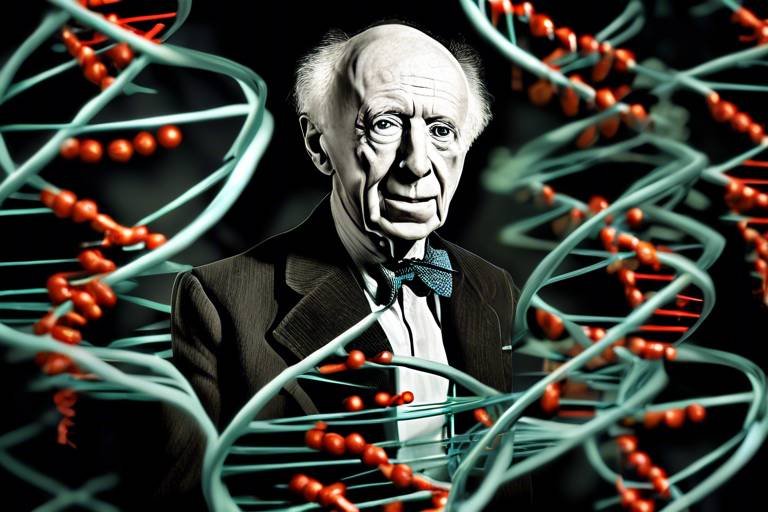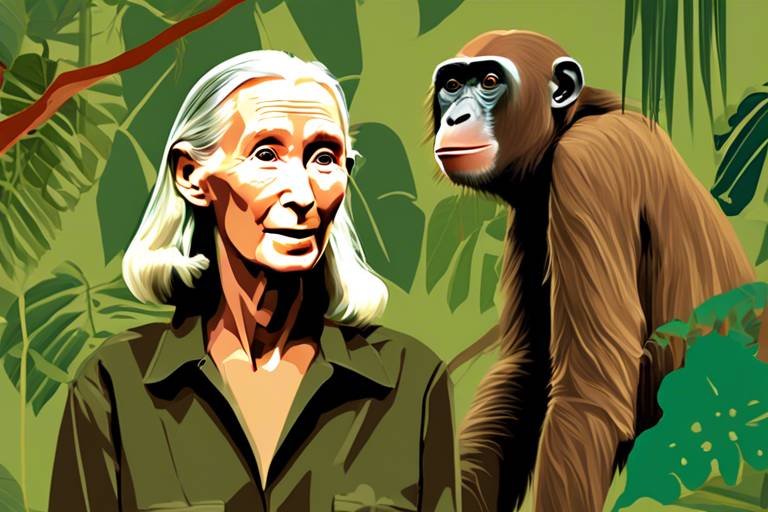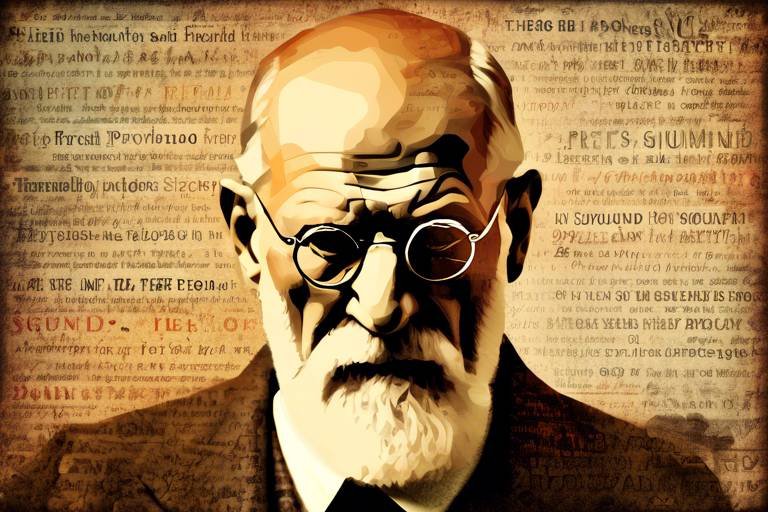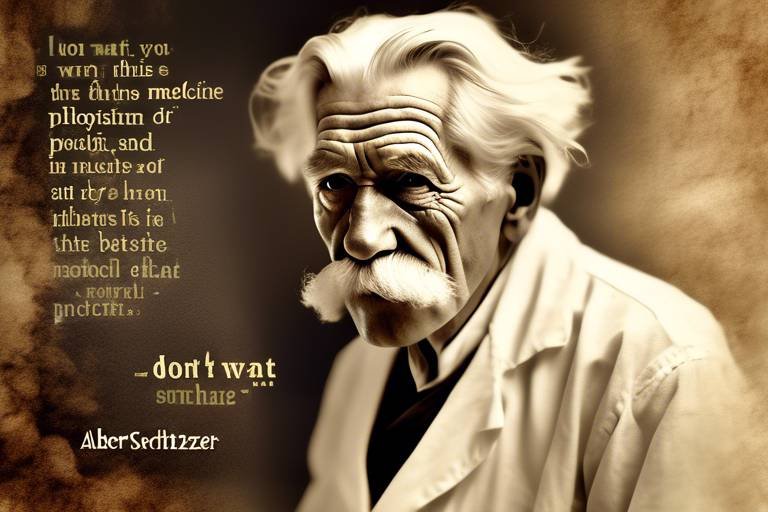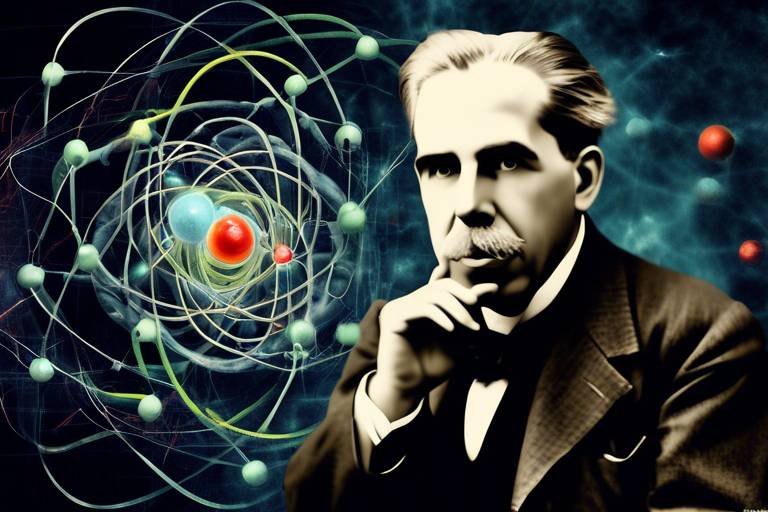James Watson and the Discovery of the DNA Double Helix
The story of James Watson and the discovery of the DNA double helix is not just a tale of scientific achievement; it’s an exhilarating journey through the realms of curiosity, collaboration, and groundbreaking revelations. Imagine a world where the blueprint of life remained a mystery, where the very essence of our genetic makeup was hidden in a complex puzzle. Watson, alongside his brilliant collaborator Francis Crick, unlocked this enigma, forever changing the landscape of molecular biology. Their work was akin to finding the missing piece of a jigsaw puzzle that, once placed, illuminated the entire picture of life itself.
In the early 1950s, the scientific community was buzzing with excitement and speculation about the structure of DNA. It was a time when the potential for understanding genetics was just on the horizon, and Watson and Crick were at the forefront of this revolution. With their combined intellects, they embarked on a mission to decode the structure of DNA, a task that would ultimately lead to one of the most significant scientific discoveries in history. Their journey was filled with challenges and revelations, and it serves as a testament to the power of collaboration and the relentless pursuit of knowledge.
But what made their discovery so revolutionary? The answer lies in the elegant structure they proposed: the double helix. This iconic shape, reminiscent of a twisted ladder, not only provided insights into how genetic information is stored and transmitted but also opened the floodgates for advancements in various fields, including genetics, medicine, and biotechnology. Watson and Crick's model was not merely a scientific breakthrough; it was a key that unlocked the door to understanding life at a molecular level.
As we delve deeper into this fascinating story, we will explore Watson's early life, the critical collaboration with Crick, the essential role played by Rosalind Franklin, and the profound implications of their discovery. Each aspect of this narrative highlights the interconnectedness of scientific inquiry and the importance of recognizing all contributors to such monumental achievements.
- What was the significance of the DNA double helix discovery?
The discovery provided a fundamental understanding of how genetic information is stored and replicated, paving the way for modern genetics. - Who were the key figures involved in the discovery of DNA structure?
The key figures were James Watson, Francis Crick, and Rosalind Franklin, whose work was crucial to the development of the double helix model. - How did Rosalind Franklin contribute to the discovery?
Franklin's X-ray diffraction images were critical in helping Watson and Crick visualize the helical structure of DNA. - What are the implications of the DNA double helix discovery today?
The discovery has led to advancements in genetic engineering, medicine, and the Human Genome Project, impacting multiple industries.

The Early Life of James Watson
James Watson was born on April 6, 1920, in Chicago, Illinois. Growing up in a bustling city, he was surrounded by a blend of cultures and ideas that sparked his curiosity. From a young age, Watson exhibited a keen interest in nature and science, often spending hours exploring the local parks and observing the world around him. This early fascination with the natural world would lay the foundation for his future groundbreaking work in molecular biology.
Watson's educational journey began at the University of Chicago, where he was exposed to a rigorous academic environment. It was here that he first encountered the world of genetics, which captivated him. He was particularly influenced by the work of scientists like Hermann Joseph Muller, who was known for his research on mutations. Watson's enthusiasm for genetics was further fueled by his exposure to the emerging field of molecular biology, which was gaining momentum during the 1940s.
In addition to his academic pursuits, Watson's early life was marked by a series of experiences that shaped his character and work ethic. He was known for his competitive spirit and determination, traits that would later serve him well in the high-stakes world of scientific research. Watson often participated in various science fairs and competitions, showcasing his innovative ideas and projects. These experiences not only honed his scientific skills but also instilled in him a sense of resilience and a drive to succeed.
During his time at the University of Chicago, Watson also developed a profound appreciation for collaboration. He recognized that science is not a solitary endeavor but rather a collective effort that thrives on the exchange of ideas. This understanding would become pivotal in his later partnership with Francis Crick, as they worked together to unravel the mysteries of DNA.
Watson's early life was characterized by a blend of curiosity, ambition, and a commitment to scientific discovery. His formative years shaped not only his career path but also his approach to science, emphasizing the importance of collaboration and the relentless pursuit of knowledge. As he ventured into the world of molecular biology, he was well-equipped with the skills and mindset needed to tackle one of the most significant scientific challenges of his time: uncovering the structure of DNA.

The Collaboration with Francis Crick
James Watson's partnership with Francis Crick was nothing short of revolutionary in the realm of molecular biology. Their collaboration, which blossomed in the early 1950s at the University of Cambridge, was fueled by a shared curiosity and a relentless quest for knowledge. Imagine two brilliant minds, each bringing their unique perspectives and expertise to the table, much like a dynamic duo in a thrilling detective novel, piecing together clues to solve one of science's greatest mysteries: the structure of DNA.
Watson, an ambitious young scientist with an insatiable thirst for discovery, and Crick, a more seasoned physicist with a knack for theoretical modeling, complemented each other perfectly. Their relationship was characterized by intense discussions, brainstorming sessions, and the occasional friendly debate. This intellectual synergy was critical in navigating the complexities of DNA structure, as they combined Watson's background in genetics with Crick's understanding of physical sciences. Together, they formed a formidable team that would eventually unveil the double helix, a breakthrough that would change the course of biology forever.
One of the most fascinating aspects of their collaboration was the way they approached problem-solving. They often relied on models and visual representations to conceptualize ideas. For instance, they built physical models of DNA using materials like wire and cardboard, allowing them to visualize the potential structures. This hands-on approach was instrumental in helping them understand the intricate details of the DNA molecule. It’s akin to how architects create blueprints before constructing a building; they needed a solid foundation to support their groundbreaking theories.
Moreover, their collaboration was not just about the two of them. They were part of a larger scientific community, often engaging with other researchers and exchanging ideas. This open communication fostered an environment of innovation and creativity. Watson and Crick's ability to synthesize information from various sources, including the pivotal X-ray diffraction images produced by Rosalind Franklin, exemplifies the importance of collaboration in scientific advancements. Without the contributions of others, their work might not have achieved the same level of success.
In essence, the partnership between Watson and Crick serves as a powerful reminder of the value of collaboration in science. Their journey illustrates that great discoveries are rarely the result of solitary efforts but rather the culmination of teamwork, shared insights, and mutual respect. Their groundbreaking work on the DNA double helix not only revolutionized genetics but also set a precedent for future scientific collaborations, inspiring countless researchers to work together toward common goals.

The Role of Rosalind Franklin
Rosalind Franklin was a brilliant scientist whose contributions to the understanding of DNA cannot be overstated. Often overshadowed by her male counterparts, Franklin's work was pivotal in unveiling the mysteries of the genetic material that underpins all life. Her meticulous approach to science and her groundbreaking techniques in X-ray diffraction provided the essential data that James Watson and Francis Crick needed to formulate their double helix model.
Franklin's most significant achievement came in the form of X-ray diffraction images of DNA, particularly the famous "Photo 51," which revealed the helical structure of the molecule. This image was a game-changer, serving as a visual key that unlocked the complex architecture of DNA. Without her precise measurements and insights, Watson and Crick might have struggled to piece together the complete picture of DNA's structure. It's like trying to solve a jigsaw puzzle with half the pieces missing; Franklin provided those crucial pieces that made the puzzle whole.
Despite her critical role, Franklin faced considerable challenges, not just in her research but also in gaining recognition for her work. Gender bias was rampant in the scientific community during her time, and her contributions were often minimized or overlooked. It raises the question: how many other brilliant women have been lost to history because their work was overshadowed by their male colleagues? Franklin's story serves as a poignant reminder of the need for equitable representation in science.
In addition to her X-ray work, Franklin's expertise in physical chemistry allowed her to conduct rigorous analyses that paved the way for understanding DNA's properties. She was not merely a contributor; she was a trailblazer who laid the groundwork for future discoveries in molecular biology. This highlights the importance of collaboration in science, where diverse perspectives can lead to groundbreaking advancements.
In conclusion, Rosalind Franklin's contributions to the discovery of the DNA double helix are invaluable. Her story is not just about science; it's about the recognition and respect that women in science deserve. As we celebrate the achievements of Watson and Crick, we must also honor Franklin's legacy and ensure that future generations of scientists, regardless of gender, receive the acknowledgment they rightfully deserve.

Rosalind Franklin's contributions to the discovery of the DNA double helix are often overshadowed, yet her work was nothing short of revolutionary. Among her most significant achievements were the X-ray diffraction images of DNA, which provided critical insights into its structure. Imagine trying to piece together a puzzle with only a few scattered pieces; that's how Watson and Crick approached the DNA model before encountering Franklin's images. Her meticulous technique and attention to detail allowed her to capture the helical shape of DNA with remarkable clarity, which ultimately guided Watson and Crick in their groundbreaking work.
Franklin's famous Photograph 51, an X-ray diffraction image, showcased the characteristic cross pattern indicative of a helical structure. This image was pivotal, acting as a beacon of clarity in a field filled with uncertainty. The pattern revealed not only the helical nature of DNA but also hinted at the dimensions of the molecule, including the distance between the bases and the overall width of the helix. Watson and Crick, upon viewing this image, were able to visualize the double helix, which was a significant leap forward in understanding genetic material.
Moreover, Franklin's work exemplified the importance of empirical data in scientific discovery. She didn't just theorize; she provided the hard evidence that could be analyzed and interpreted. Her approach to science was methodical, as she meticulously gathered data and conducted experiments that laid the groundwork for future research. In a time when the contributions of women in science were often overlooked, Franklin's dedication and expertise serve as a reminder of the essential role women have played in scientific advancements.
However, it is crucial to acknowledge the broader context of her work. Despite her groundbreaking contributions, Franklin faced significant challenges due to the gender bias prevalent in the scientific community of her time. Her findings were often dismissed or underappreciated, and it was only later that the scientific community began to recognize the depth of her contributions. This raises important discussions about the need for equitable representation in science and the recognition of all contributors, regardless of gender.
In summary, Franklin's X-ray diffraction images were not just photographs; they were the keys that unlocked the door to understanding the molecular structure of DNA. Her work remains a testament to the power of empirical evidence and the often-unseen contributions of women in the scientific field. As we celebrate the discovery of the DNA double helix, we must also honor the legacy of Rosalind Franklin and ensure that her story is told alongside that of Watson and Crick.

The story of Rosalind Franklin is not just a tale of scientific brilliance; it is also a powerful reminder of the gender bias that has historically plagued the scientific community. Despite her significant contributions to the discovery of the DNA double helix, Franklin's work was often overshadowed by her male counterparts. This bias raises critical questions about how we recognize and celebrate the achievements of women in science. Why is it that the contributions of women are frequently relegated to the background? Why do we often hear about the names of men like Watson and Crick while Franklin's name is less frequently mentioned?
Franklin's research was groundbreaking, and her X-ray diffraction images of DNA were instrumental in guiding Watson and Crick towards their model of the double helix. Yet, her contributions were often minimized or overlooked in the narratives that followed the discovery. This phenomenon is not unique to Franklin; it reflects a broader systemic issue within the scientific community where women's contributions have historically been undervalued. The impact of gender bias can be observed in various ways:
- Recognition: Women scientists often receive less recognition for their contributions compared to their male peers.
- Opportunities: Gender bias can limit opportunities for women in research positions and leadership roles.
- Funding: Studies have shown that female researchers may receive less funding for their projects than male researchers.
To truly appreciate the significance of Franklin's work, we must confront these biases and strive for a more equitable representation in science. By acknowledging the contributions of women like Franklin, we not only honor their legacy but also inspire future generations of female scientists to pursue their passions without the constraints of gender bias. The recognition of women's roles in scientific breakthroughs is essential for fostering an inclusive environment where all voices are heard and valued.
As we continue to explore the history of scientific discovery, let us remember that the path to progress is paved with the contributions of diverse individuals. It is crucial to ensure that the stories of women in science are told, celebrated, and integrated into the broader narrative of scientific achievement. Only then can we hope to create a future where every scientist, regardless of gender, is given the recognition they deserve.
- What was Rosalind Franklin's role in the discovery of DNA?
Rosalind Franklin's X-ray diffraction images were crucial in revealing the helical structure of DNA, which helped Watson and Crick formulate their model. - How did gender bias affect Franklin's recognition?
Despite her significant contributions, Franklin faced gender bias that led to her work being overlooked in favor of her male colleagues, impacting her recognition in the scientific community. - What can be done to combat gender bias in science today?
Increasing awareness, promoting equitable funding, and ensuring that women's contributions are recognized in scientific literature are vital steps toward combating gender bias.

The discovery of the DNA double helix by James Watson and Francis Crick was nothing short of revolutionary. Picture a twisted ladder, where the rungs represent the base pairs of nucleotides, and the sides are made up of sugar and phosphate groups. This elegant structure not only explained how genetic information is stored and transmitted but also provided a visual understanding that was previously lacking in the field of molecular biology. The double helical model, proposed in 1953, was a culmination of various scientific insights and empirical data, and it fundamentally changed our perception of life at the molecular level.
The double helix structure consists of two strands that wind around each other, creating a stable configuration that is essential for the replication and transmission of genetic information. Each strand is composed of a sequence of nucleotides, which are the building blocks of DNA. These nucleotides include four types of bases: adenine (A), thymine (T), cytosine (C), and guanine (G). The remarkable feature of the double helix is that adenine pairs with thymine, while cytosine pairs with guanine, forming what we refer to as complementary base pairing. This pairing is critical because it ensures that the genetic code is accurately copied during cell division.
Watson and Crick's model also emphasized the significance of the antiparallel orientation of the two strands. One strand runs in a 5' to 3' direction, while the other runs 3' to 5'. This orientation is crucial for the enzymes involved in DNA replication and transcription, as they can only synthesize new strands in a specific direction. The discovery of the double helix not only provided a structural framework for understanding genetic inheritance but also sparked a cascade of research that led to the development of molecular genetics as a discipline.
To illustrate the key components of the DNA structure, the following table summarizes the essential elements:
| Component | Description |
|---|---|
| Nucleotide | The basic building block of DNA, consisting of a sugar, a phosphate group, and a nitrogenous base. |
| Base Pairing | The specific pairing of adenine with thymine and cytosine with guanine, which stabilizes the DNA structure. |
| Antiparallel Strands | The two strands of DNA run in opposite directions, which is essential for replication and transcription. |
| Double Helix | The twisted ladder shape of DNA, formed by the winding of the two strands around each other. |
In conclusion, the model of DNA structure not only provided a foundational understanding of genetics but also opened the door to countless scientific advancements. It has become a cornerstone of modern biology, influencing various fields, including genetics, medicine, and biotechnology. Watson and Crick's work demonstrated that collaboration, empirical data, and creative thinking are essential in scientific discovery, and their double helix model continues to inspire researchers around the world.
- What is the significance of the DNA double helix? The double helix structure is crucial for understanding how genetic information is stored and replicated, providing insights into inheritance and molecular biology.
- Who were the key contributors to the discovery of DNA's structure? James Watson and Francis Crick are credited with the discovery, but Rosalind Franklin's X-ray diffraction images were pivotal in guiding their research.
- How has the discovery of DNA structure impacted modern science? It has led to advancements in genetic engineering, the Human Genome Project, and has influenced fields like medicine and biotechnology.

The discovery of the DNA double helix was not just a scientific milestone; it was a revolution that transformed our understanding of life itself. Imagine unraveling the very blueprint of existence! Watson and Crick’s model provided a framework that not only explained how genetic information is stored but also how it is passed from one generation to the next. This groundbreaking revelation sparked a cascade of advancements across various fields, particularly in genetics, medicine, and biotechnology.
One of the most significant implications of this discovery is its role in the Human Genome Project. Launched in the late 20th century, this ambitious initiative aimed to map all human genes, a task that would have been nearly impossible without the foundational understanding of DNA structure that Watson and Crick provided. By identifying the complete set of human genes, scientists have been able to explore the genetic basis of diseases, paving the way for targeted therapies and personalized medicine.
Moreover, the implications extend far beyond human health. The discovery of the double helix has led to remarkable advancements in genetic engineering. Scientists can now manipulate genes with precision, leading to innovations such as:
- Gene Therapy: A technique that allows the correction of defective genes responsible for disease development.
- CRISPR Technology: A revolutionary method for editing genes, enabling scientists to modify DNA sequences and regulate gene activity.
- Genetically Modified Organisms (GMOs): Enhanced agricultural practices that result in crops with improved resistance to pests and diseases.
This transformation in genetic engineering has not only improved health outcomes but has also revolutionized agricultural practices, ensuring food security in a growing world. The ability to engineer crops that can withstand harsh environmental conditions is crucial in combating the challenges posed by climate change.
Furthermore, the implications of the DNA double helix discovery stretch into the realm of forensics and criminal justice. The ability to analyze DNA has revolutionized how we solve crimes, allowing for more accurate identifications and exonerations of the wrongly accused. This molecular fingerprinting has become a cornerstone of modern forensic science, demonstrating the profound impact of Watson and Crick's work on society.
In essence, the discovery of the DNA double helix has created a ripple effect across numerous domains, influencing everything from health care to agriculture to criminal justice. It has opened doors to new fields of study and has provided the tools necessary to tackle some of the most pressing challenges of our time. As we continue to explore the implications of this monumental discovery, one thing is clear: the work of Watson and Crick laid the groundwork for a future where the mysteries of life can be decoded and manipulated, offering both exciting possibilities and ethical considerations.
- What is the significance of the DNA double helix? The DNA double helix is crucial because it explains how genetic information is stored and transmitted, forming the basis for modern genetics.
- How did the discovery of the DNA structure impact medicine? It paved the way for advancements in genetic research, leading to personalized medicine and gene therapies.
- What role did Rosalind Franklin play in the discovery? Her X-ray diffraction images were essential in helping Watson and Crick formulate their model of DNA.
- What are some applications of genetic engineering? Applications include gene therapy, CRISPR technology, and the development of genetically modified crops.

This article explores the groundbreaking contributions of James Watson to molecular biology, particularly his role in uncovering the structure of DNA, alongside his collaborator, Francis Crick.
James Watson's formative years shaped his scientific curiosity and passion for genetics, laying the groundwork for his later groundbreaking research in molecular biology and the discovery of the DNA structure.
Watson's partnership with Crick was pivotal in the discovery of the DNA double helix, illustrating the importance of collaboration in scientific advancements and the dynamics of their intellectual relationship.
Rosalind Franklin's contributions, particularly her X-ray diffraction images of DNA, were crucial in guiding Watson and Crick toward their groundbreaking model, highlighting the often-overlooked contributions of women in science.
Franklin's meticulous X-ray images provided key insights into the helical structure of DNA, serving as the foundation upon which Watson and Crick built their model, showcasing the significance of empirical data in scientific discovery.
Despite her critical contributions, Franklin faced significant gender bias in the scientific community, raising important discussions about the recognition of women in science and the need for equitable representation.
Watson and Crick's model of DNA structure revealed the double helix configuration, providing a framework for understanding genetic inheritance and molecular biology, which revolutionized the field of genetics.
The discovery of the DNA double helix had far-reaching implications, influencing fields such as genetics, medicine, and biotechnology, and paving the way for advancements in genetic engineering and molecular biology.
The Human Genome Project (HGP), initiated in 1990 and completed in 2003, stands as one of the most ambitious scientific endeavors in history. Its primary goal was to map and understand all the genes of the human species, which amounts to approximately 20,000 to 25,000 genes. This monumental project was made possible largely due to the foundational understanding of DNA structure that Watson and Crick provided. Without their insights into the double helix, the complexities of genomic mapping might have remained elusive.
The implications of the HGP are monumental. By identifying the sequences of the three billion base pairs that make up human DNA, scientists have opened the door to numerous breakthroughs in medicine and biology. Some of the key outcomes of the Human Genome Project include:
- Enhanced Understanding of Genetic Disorders: The mapping of human genes has led to better diagnostics and potential treatments for genetic diseases.
- Personalized Medicine: Knowledge of an individual's genetic makeup can inform tailored treatment plans, optimizing efficacy and minimizing side effects.
- Advancements in Biotechnology: The HGP has fueled innovations in genetic engineering, allowing for the development of genetically modified organisms (GMOs) and improved agricultural practices.
Moreover, the HGP has fostered international collaboration among scientists, leading to the establishment of databases and resources that are now invaluable for ongoing research. The project not only mapped the human genome but also set the stage for future genomic projects across various species, enhancing our understanding of biology as a whole.
In essence, the Human Genome Project is a testament to how the discovery of DNA's structure has transformed the landscape of science and medicine. It has provided a roadmap for understanding our biology, and its impact continues to resonate in today's research and healthcare practices.
- What was the main goal of the Human Genome Project? The main goal was to map the entire human genome, identifying all the genes and their functions.
- How has the Human Genome Project impacted medicine? It has led to advancements in personalized medicine, improved diagnostics, and potential treatments for genetic disorders.
- What role did Watson and Crick play in the Human Genome Project? Their discovery of the DNA double helix provided the foundational understanding necessary for the mapping of the human genome.

The discovery of the DNA double helix has paved the way for revolutionary advancements in genetic engineering, a field that has dramatically transformed our understanding of biology and medicine. Imagine being able to edit the very code of life itself! This is not just science fiction; it’s a reality made possible by the foundational work of James Watson and Francis Crick. Their model of DNA structure opened the door to manipulating genetic material, allowing scientists to alter genes with unprecedented precision.
One of the most significant breakthroughs in genetic engineering is the development of CRISPR-Cas9 technology. This powerful tool allows researchers to make targeted changes to the DNA of living organisms. With CRISPR, scientists can effectively “cut and paste” genes, leading to potential cures for genetic disorders, advancements in agriculture, and even the creation of genetically modified organisms (GMOs). For example, crops can be engineered to be more resistant to pests and diseases, which can significantly enhance food security.
Moreover, genetic engineering has led to the emergence of gene therapy, a treatment method that involves altering the genes inside a person's cells to treat or prevent disease. This approach has shown promise in treating conditions like cystic fibrosis, hemophilia, and certain types of cancer. By correcting or replacing faulty genes, gene therapy can potentially provide long-lasting solutions to previously incurable diseases.
As we delve deeper into the implications of genetic engineering, it’s essential to consider the ethical dimensions. The ability to edit genes raises questions about the potential for designer babies and the long-term effects of genetic modifications on ecosystems and human health. It’s a double-edged sword that requires careful consideration and regulation.
In summary, the advances in genetic engineering made possible by the understanding of DNA structure have not only transformed scientific research but have also opened new avenues for medical treatments and agricultural innovations. The journey from the discovery of the DNA double helix to the cutting-edge techniques we have today illustrates the profound impact that foundational scientific research can have on society.
- What is genetic engineering?
Genetic engineering is the direct manipulation of an organism's genes using biotechnology. It involves altering the genetic makeup to achieve desired traits. - How has CRISPR changed genetic engineering?
CRISPR-Cas9 technology allows for precise editing of DNA, enabling targeted changes that can lead to significant advancements in medicine and agriculture. - What are the ethical concerns surrounding genetic engineering?
Concerns include the potential for creating designer babies, unforeseen consequences on ecosystems, and the implications of genetic modifications on human health. - Can genetic engineering cure diseases?
Yes, techniques such as gene therapy aim to treat genetic disorders by correcting or replacing faulty genes, offering hope for conditions that were previously untreatable.
Frequently Asked Questions
- What was James Watson's role in the discovery of the DNA double helix?
James Watson played a pivotal role in uncovering the structure of DNA alongside his collaborator, Francis Crick. Their teamwork and innovative thinking led to the formulation of the double helix model, which revolutionized our understanding of genetics and molecular biology.
- How did Rosalind Franklin contribute to the discovery of DNA's structure?
Rosalind Franklin's meticulous X-ray diffraction images of DNA were crucial in guiding Watson and Crick toward their groundbreaking model. Her work provided essential insights into the helical structure of DNA, although her contributions were often overlooked during her time.
- What were the implications of the DNA double helix discovery?
The discovery of the DNA double helix had profound implications across various fields, including genetics, medicine, and biotechnology. It laid the groundwork for advancements such as the Human Genome Project and genetic engineering, significantly influencing the future of science and health.
- What impact did gender bias have on Rosalind Franklin's recognition?
Despite her critical contributions, Rosalind Franklin faced significant gender bias in the scientific community. This bias not only affected her recognition during her lifetime but also sparked important discussions about the need for equitable representation of women in science.
- How did the DNA double helix model influence genetic engineering?
The double helix model of DNA has led to groundbreaking advancements in genetic engineering, allowing scientists to manipulate genes and develop new therapies. This has transformed various industries, from healthcare to agriculture, showcasing the model's lasting impact.
- What is the Human Genome Project, and why is it important?
The Human Genome Project was an ambitious initiative aimed at mapping all human genes. Understanding the structure of DNA was foundational for this project, highlighting the significance of Watson and Crick's work in modern genetics and genomics.

